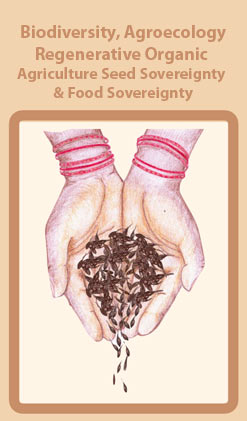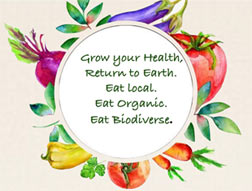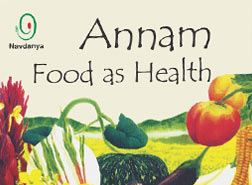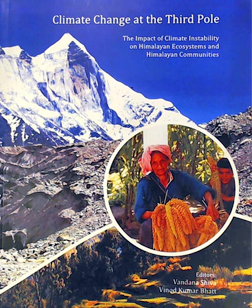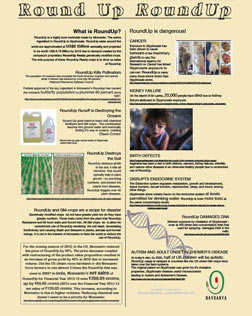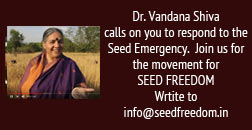Week 4 – Living Seed
This final week of the A-Z course highlighted the soul of agriculture, food and the work we do here at Navdanya, the living seed. We began with an introduction to seed saving, selection and conservation by our own Dr. Vinod Bhatt, Navdanya’s executive director. This was followed by two days explanation and instruction on breeding by Dr. Salvatore Ceccarelli, an expert in participatory plant breeding and evolutionary plant breeding. Dr. Ceccarelli took us out into the fields and explained how farmers are able to breed their crops to suit their agroecological regions, therefore producing more resilient and climate adapted varieties. Participants learned that farmers have been active agents in the process of seed selection and production and that this has, with the process of time, become an external practice and thereby separated the farmer from this process. Dr. Ceccarelli has successfully been working in different parts of the world to include local farmers in the process of variety production. Dr. Seema Chaudhary connected pollination and selection back to the friendly insects and pollinators on our fields. Irrigation was a question in the minds of the participants so our National Program Coordinator Mr. Darwan Singh Negi, explained to the group how irrigation is place and soil specific, like many other aspects of agroecological farming, the systems we use on our farm are not applicable in more arid areas. He shared some simple techniques to conserve and increase water levels. Mr. Negi also presented to the group the situation in the Mandakini Valley and Navdanya’s relief efforts with farmers and village members in the area. Dr. Vandana Shiva brought to light the political dimension of the seed and the global movements for seed freedom, inviting each and every one of us to join the movement and take it home with us.
The daily practicals brought us closer to seed through seed selection from the fields, seed sorting at our seed bank and a special session where we exchanged seeds with local women from seed banks nearby. In addition to this we took participants to a nearby community seed bank allowing for a dialogue between course participants and these women who are actively saving local seeds. The course concluded with a special guest speaker, Dr. Saamdu Chetri the director of Bhutan’s Gross National Happiness center. He shared his insights and Bhutan’s intentions for initiating and using GNH as a measure of development. By closing with a guided meditation Saamdu Ji reminded us that it was time for us to go out and begin planting seeds across the world.
Week 3 – Living Food
This week was focused on the food on our plate and in our systems. Beginning with Dr. Anna Powar who introduced us to the basics of nutrition and health, followed by another session on food misconceptions and how our diets should be rooted to place and our ancestors. Each region and place has built their food habits over generations, resulting in healthy and local food. She showed participants the different types of condiments and sauces that are made around the world, packed with vitamins, proteins, and oils such as pesto, mint chutney, tahini, and harissa. We also had the privilege of celebrating Dr. Powar’s birthday here on our farm. The conversations shifted towards the harmful food in our diet and food system today. Dr. Mira Shiva and Dr. Vaibhav Singh discussed with the participants the poisons present in our food in the form of pesticides and fertilizers. As a result of this current system many native and nutritious foods have been forgotten, Ms. Maya Goburdhun took us through the history of this shift and shared the foods Navdanya is reviving through our projects. She also had course participants share the forgotten foods from their regions. Navdanya’s director of research and programs, Dr. Vinod Kumar Bhatt, explained to the group how Navdanya is placing itself within this food system to provide just and fair food.
Our practical’s this week was cooking with forgotten foods, especially millets. We prepared amaranth cutlets, a Navdanya speciality, amaranth ladoos, jowar (sorghum) khichdi, and bajra (pearl millet) soup. Mrs. Kusum Mishra shared recipes for Dal Puri and Dahi Baingan (eggplant and yoghurt vegetable). A world café style session was organized with the help of the interns and volunteers to demonstrate the adulteration in our foods and how plants absorb nutrients. This was followed by Chris Kennedy and Marilyn McHugh’s presentation of a solution to this problem; as most of us live in urban areas, they demonstrated how to grow food in urban spaces so we have more say in the food we eat. On the day of Onam, course participants from Southern India prepared sandhya, the traditional meal eaten on this harvest festival day. We concluded the week with a Navdanya farm cook-off where participant groups got one inspirational ingredient to cook a dish and were invited to go out to the fields to piece this together. This culminated in a group meal with shared food, made from the farm. Now that the connections between humans, our food and the soil have been made, next week we move on to the Living Seed, the essence from which life is derived.
“The forgotten food was great because you realize you can do something about it, by saving seeds and cooking with those kinds of food you can help them survive. You also get to know more about your history, why your ancestors grew those kinds of foods, geographical reasons. You increase the possibility to grow more nutritious food with biodiversity. When we were asked to share at first I thought I didn’t have any forgotten foods of my country, but deep inside as I searched I realize I do know some food from listening to others, my grandma and family.”
- Stefan Ortiz, participant from Columbia.
“Our body, the environment and the food growing on this land proves that we are born from the same soil because there is a perfect synchronization that is disturbed by an alien thing so it’s completely thought out. If ragi [finger millet] is growing here it’s because the environment needs it and so does our body.”
- Disha Mehta, participant from Kolkata, West Bengal
Week 2 – Living Soil and the Web of Life
The second week of the course was focused on the life below our feet. We began with Mr. Hari Raj Singh leading a session on living soil and explaining what makes up the ground we live our lives upon. Chris Kennedy and Marilyn McHugh, from theHummingbird Project,took participants through the soil food web, explaining the value and inseparable connection of life within the soil, the nutrients available to plants, animals and us human beings. Their microbe treasure hunt sent participants searching in different locations to collect dirt to observe and identify the microorganisms in our soil. Dr. Avinash Singh highlighted the importance of plant health with soil health and how to maintain the health of plants by understanding the essential nutrients needed. From Orissa, Dr. Panigrahi, a retired professor of zoology, shared his experience and knowledge on soil fertility, climate resilience and pest management through ecological alternatives. Following in this vein, Dr. Uniyal stressed the importance of pollinators and friendly insect’s role in agriculture and ecology and the present stresses on these populations.
Each morning`s teaching session was followed by an afternoon practical session on making different kinds of compost and soil inoculants using materials available from and around our farm. These included vermicompost, ghan amrit, panchgavya, heap compost, vermiwash, jeev amrit, and pit compost. On the final day of the week we learned to make plant based pesticides using leaves and berries as well as a garbage enzyme from our kitchen waste. Our week would go incomplete without a cooking session, this time we made sweet dishes; apple jam and two preparations from Orissa with Mrs. Kusum Mishra called Kakara (a coconut and dried fruit puff) and Sooji Munda (a sweet boiled dumpling made with semolina filled with coconut and dried fruits). More forgotten food cooking will be coming up in the next week as we learn about Living Food.
“We were learning about microorganisms in the soil and as a geologist we only deal with dead matter, so this helped me learn about the interaction between the living environment and dead matter. I realized plants have the same digestive system as we do in our stomach; it was great to see that plants are the same. If you put chemicals in them like us with antibiotics, the system collapses inside, so you have to heal them again by taking care of your soil.” - Spela Bavec, participant from Slovenia
“When we think about organic we only think about food, but now we realize it’s all related, the soil, insects, animals, birds. At the end you realize you don’t have to take care of one thing, but consider it all, like a family, you think about everybody in that circle.” – Seeza Bhardwaj, Pathankot, Punjab.
Week 1 - Understanding Food and Farming Systems: A Systems Approach
The course began with participants from all over India and 11 different countries joining us to learn about organic farming and agroecology at Navdanya’s Biodiversity Conservation Farm and Bija Vidyapeeth outside of Dehradun in Uttarakhand. The first few sessions were led by our founder, Dr. Vandana Shiva, who placed our existing system in context. Currently, the world is reduced to particles, nutrients, elements, and mechanical parts; what gets ignored here is the complex system where the earth is a living whole, dynamic and self-organized. From our own experience and of others, increased disconnection and separation from the source has had great repercussions. As a response to this during these first few days, while participants were getting oriented and learning about the farm’s diversity and lifestyle, participants learned to cook using food directly from our fields, highlighting our connection to the source. We made two dishes, seasonal to this time of year, pakoras made from ground corn, pumpkin flowers and leaves and corn pancakes. A farm tour took the participants through our fields where rice, millets, corn, groundnut, okra, lentils, gourds and much more are growing. The premature rains and successive floods of this past June brought with it 1.5 feet of sand onto our fields and washed away our crops. This damage has been replaced by 650 varieties of rice, lentils, millets and vegetables; participants witnessed the resilience of Mother Nature first hand. The following few days were a whirlwind of information absorption and sharing, where Dr. Avinash Singh took participants through the basics of organic farming, agroecology and agronomy. A number of participants are thinking about land or have already begun working on some land; to facilitate this Dr. Singh had them ideate about their ideal farm, think about what they want to do with the land and use the space. Participants came up with well thought-out and conscientious images of what their farm would be like and shared it with each other, allowing for them to exchange ideas and techniques. Nightly documentaries have also opened up thoughtful conversation and dialogues about the current system, how we are implicated in it and has led to questions about the opposing point of view. The following week, titled ‘Living Soil and the Web of Life’, is going to be packed with soil microbiology and soil health information and the group is looking forward to getting their hands into some compost.
“Companion planting is a pattern represented in the group of participants of this A-Z course ” – Mohit Handa, Chennai.
“I have learned it’s all about observation and knowing why, if you want to be a farmer it’s important to know why” – Isabelle Schummers, Luxembourg.


